Based on a picking list which contains all information about the article and the storage location, the order picker takes the indicated quantity out of the storage location and ticks off the article in the list. Feedback to the warehouse management system is given once all positions of the list have been processed. The disadvantages of this system are in particular the processing time when order picking as well as the susceptibility to mistakes and errors through wrong storage locations, stock quantities or picking errors. That is why further, other procedures are applied or preferred to automate data acquisition and identification.
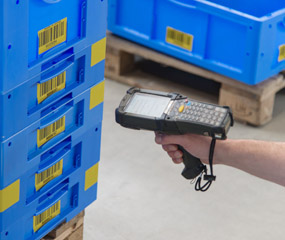
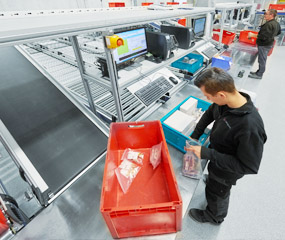
Here, the picking list is displayed on a device for mobile data acquisition, the terminal or hand-held device. This device, which is connected to the warehouse management system, allows entering quantities picked and shortfall quantities. Thanks to a hand-held scanner frequently integrated, the bar code of a pallet or a tote is scanned and the associated information are shown on the display. Applying this order picking method, you only have one hand free.
When picking at the stationary PC, the scanner is used to record the barcode on the load carrier or to identify goods. All other processes are carried out on the PC. The advantage is, among other things, a larger display. This makes it possible to display more information about the process than is the case with a mobile handheld. Often these are, for example, images of articles or an overview of target pallets. A stationary workstation with a PC is usually used for the goods-to-man principle. Load carriers are transported directly to the picking station, usually by means of automation.
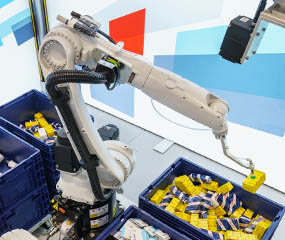
Picking workstations can be fully automated with AI-based robotics. The intelligent image recognition of the picking robots identifies a wide range of products which are supplied in containers by shuttle systems or other small parts stores. The robot recognizes the position of randomly distributed products at different heights, picks them up and places them accurately into order containers or shipping cartons. A trouble-free “grip into the box” is thus ensured.
The picking robots are seamlessly integrated into the state-of-the-art warehouse management system KlinkWARE via standard interface, thus receiving your picking orders. The particular advantage of this technology is its performance. Robot-based piece picking stations achieve up to 1000 picks per hour. They can significantly increase throughput in logistics centers by working with a robot in several shifts. The technology is very versatile, because the robot uses self-learning algorithms to continuously improve the tasks assigned to it.
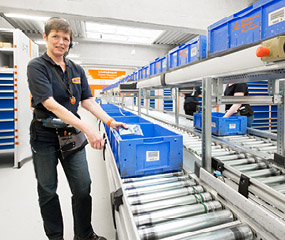
The paper-based picking list is replaced by a headset with voice recognition function which is directly in contact with the warehouse management system. A computer voice communicates the picking instructions to the user who then may confirm the picking process by previously defined words or numbers. As hands are free and the user does not have to look at a display, this technology allows achieving a high picking performance. The advantages of pick-by-voice are a high flexibility, simple scalability and low error rates. The voice recognition is ensured by voice profiles which each voice user generates himself / herself when setting up the system by simply saving the frequencies of his/her command words. This way, the order picker is able to enter the words also in his or her mother tongue. Using the pick-by-voice method, the warehouse staff has hands free and an unobstructed view during order picking. Via check digits, it is possible to quickly and reliably acknowledge the localization and identification of the right products at the picking location and to confirm order picking into the correct tote.
The special feature at Klinkhammer: Through self-developed software tools, Klinkhammer supports order picking, inventory or assembly processes using pick-by-voice technology by expanding or adjusting dialogues. This is possible because Klinkhammer does not use rigid but flexible pick-by-voice systems. Our customized dialogues and notes which the user receives via his headset make work much easier and additionally increase the picking quality.
Frequently, customer orders consist of several positions or items which have to be merged for shipping. Techniques for order picking assist in putting together articles from different warehouse areas in an error-free and cost-effective manner.
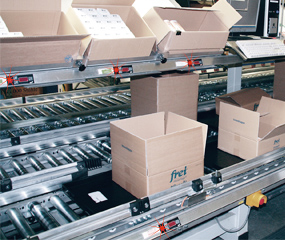
Each time when starting a picking order, e.g. by means of scanning a bar code, the warehouse management system activates a display installed at the tote location or storage location. Thanks to the digital quantity display directly at the storage location the order picker is able to see immediately how many parts he or she has to pick from this location. Depending on the user, the displays may also light up in different colours. Hence, the likelihood of confusion is largely minimized. By pressing the acknowledgment button at the storage location display the quantity is registered in the warehouse management system.
Hands are free during order picking and the user does not lose time when searching for order positions. New, flexible technologies with wireless, battery-controlled display modules are already in the process of being launched. As the pick-by-light displays are installed at the storage locations, the order picking process guided by pick-by-light is less flexible and thus more time-consuming and more costly in case adaptations become necessary. Given that it is extremely easy to familiarize new employees with this system, the employment of seasonal workers is significantly facilitated in case of strongly fluctuating order volumes.
With the most recent, state-of-the-art order picking method, the storing position and picking quantity of a product appear in the data googles display. These googles connect to the warehouse management system via WLAN and are able to determine the position of the order picker and his viewing direction by means of a position detection system, e.g. a camera with image recognition software. The data is displayed depending on the context, i.e. depending on the site, time, visual field looked at and status of order processing. By shortly touching the goggles, an integrated scanner reads the bar code of the storage location as soon as this storage location is looked at and shows the number of products to be picked in the data goggles. If the employee is standing in front of the wrong storage location, a note is displayed in the goggles display indicating the correct space. The next order is started by shortly touching the goggles. Besides a high picking rate, the advantages of the pick-by-light order picking consist in reducing errors during picking by a visual representation of article images, checking the article numbers in the field of vision as well as by highlighting the storage compartment optically. A reduction of non-productive times and thus a performance increase is achieved by displaying different path and picking information simultaneously. In terms of quality and ergonomics of the data googles, the next years are certainly expected to bring significant progress for order picking.